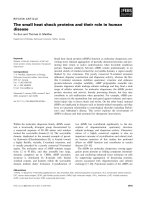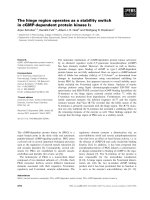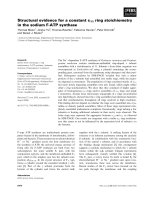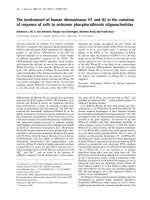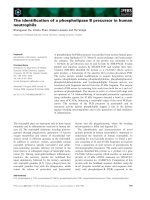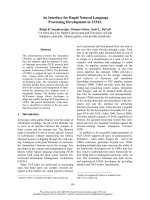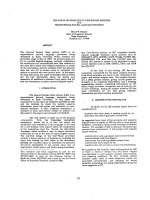Báo cáo khoa học: "The preference for water nipples vs. water bowls in dairy goats" pot
Bạn đang xem bản rút gọn của tài liệu. Xem và tải ngay bản đầy đủ của tài liệu tại đây (193.59 KB, 21 trang )
This Provisional PDF corresponds to the article as it appeared upon acceptance. Fully formatted
PDF and full text (HTML) versions will be made available soon.
The preference for water nipples vs. water bowls in dairy goats
Acta Veterinaria Scandinavica 2011, 53:50 doi:10.1186/1751-0147-53-50
Knut E Boe ()
Rebecca Ehrlenbruch ()
Inger L Andersen ()
ISSN 1751-0147
Article type Research
Submission date 7 July 2011
Acceptance date 22 September 2011
Publication date 22 September 2011
Article URL />This peer-reviewed article was published immediately upon acceptance. It can be downloaded,
printed and distributed freely for any purposes (see copyright notice below).
Articles in Acta Veterinaria Scandinavica are listed in PubMed and archived at PubMed Central.
For information about publishing your research in Acta Veterinaria Scandinavica or any BioMed
Central journal, go to
/>For information about other BioMed Central publications go to
/>Acta Veterinaria Scandinavica
© 2011 Boe et al. ; licensee BioMed Central Ltd.
This is an open access article distributed under the terms of the Creative Commons Attribution License ( />which permits unrestricted use, distribution, and reproduction in any medium, provided the original work is properly cited.
1
The preference for water nipples vs. water bowls in dairy goats
Knut E. Bøe*
§
, Rebecca Ehrlenbruch*, Inger L. Andersen
Norwegian University of Life Sciences, Department of Animal- and Aquacultural Sciences,
P.O. Box 5003, 1432 Ås, Norway
E-mail addresses:
Knut Egil Bøe
Rebecca Ehrlenbruch
Inger Lise Andersen
*These authors contributed equally to this work
§
Corresponding author
Corresponding author: Knut Egil Bøe, (Norwegian University of Life Sciences, Department
of Animal- and Aquacultural Sciences, P.O. Box 5003, 1432 Ås, Norway,
telephone +47 64965170; fax: +47 64965101).
2
Abstract
Background: Previous studies have reported that the design of the water dispensers can
influence the water intake in farm animals. Horses and dairy cows seem to prefer to drink
from an open surface whereas sheep and pigs apparently prefer water nipples, probably
because of the worse water quality in water bowls. The aim of the present study was to
examine the preference of dairy goats for water nipples or water bowls.
Methods: In each of the two experiments (exp. 1, dry goats, exp. 2 lactating goats), 42 dairy
goats were allotted into 6 groups of 7 goats. In period 1, the goats had access to a water
nipple. In period 2, they had access to a water bowl and in period 3 (preference test) they had
access to both a water nipple and a water bowl. Water usage and wastage was recorded and
water intake (water usage – water wastage) was calculated for each group for the two last
days of each period. In experiment 2, water samples from each dispenser were analyzed for
heterotrophy germs at 22º C, Escherichia coli and turbidity.
Results: Water usage was higher from water nipples than from water bowls both in
experiment 1 (dry goats) and experiment 2 (lactating goats). There was however, no
difference in water intake from water nipples and water bowls. In the preference test (period
3), the water intake tended to be higher from the water nipple than from the water bowl both
for the dry goats (exp. 1) and lactating goats (exp. 2). Especially for the dry goats, the
differences between groups were large. Turbidity and heterotrophy germs were much higher
in the samples from the water bowls than from the water nipples.
Water wastage from the water bowls was negligible compared to the water nipples. From the
water nipples the water wastage was 30 % and 23% of water usage for the dry and lactating
goats respectively.
3
Conclusions:
We conclude that type of water dispenser (nipple or bowl) was probably of minor importance
for water intake in goats, but water bowls had a lower water quality.
(Key words: goat; water dispenser)
4
Background
The literature on water intake in goats is scare, and the studies mainly concern goats living in
desert conditions under heat stress and/or water restrictions [e.g. 1]. In temperate climates, the
water intake for goats is reported to be 139 g/kg W
0.75
at mid-pregnancy, and lactating goats
need 1.28 kg of water to produce one kg milk [2]. Ehrlenbruch et al. (2010) measured the
water intake in lactating goats to be 6.2 and 4.4 liters/day when fed hay and silage,
respectively [3].
Previous studies have reported that the design of the water dispensers can influence the water
intake, and many farm animals species seem to prefer to drink from a water source with a
large and open surface (horses: [4]; cows: [5, 6]). However, both in pigs [7, 8] and in sheep
[9] the water intake was higher from nipple drinkers than from water bowls. The water quality
seems to be important for the lower intake from water bowls, and both Bøe (1984) and Bøe
and Kjelvik (2011) reported a clear reduction in water quality in water bowls [9, 10]. Brooks
and Carpenter (1989) found that in weaned piglets, the water intake from bowls declined
when the water became fouled with feed or feces [11]. To our knowledge, there is at present
no data on preference for type of water dispenser in goats, but a survey of Norwegian goat
herds showed that use of water bowls had a negative effect on both somatic cell count and
bacterial count in the goat milk [12].
Water wastage seems to be much higher on nipple drinkers than on different types of water
bowls both in pigs [7, 8, 13] and in sheep [9]. The amount of water wastage from nipples can
be somewhat reduced by adjusting the nipple heights to the shoulder height of the pigs and by
reducing the flow rate [13, 14]. High amounts of water wastage will increase the water usage,
5
impair the quality of the lying surface in pens with bedding and increase the necessary
volume of manure storage.
The aim of the present study was to examine the preference in dairy goats for water nipples or
water bowls. Based on previous studies in sheep and pigs, we predicted that goats would
prefer to drink from water nipples and that the water quality will be worse in water bowls.
Methods
Experimental design
In each of the two experiments, six groups of seven dairy goats were allotted to experimental
pens with one water nipple and one water bowl for 12 days. During period 1 (4 days) the
goats had only access to the water nipple. In period 2 (4 days) they had only access to the
water bowl, and during the actual treatment in period 3 (4 days), the goats had access to both
the water nipple and the water bowl.
Water equipment and experimental pens
The experiments were conducted in an insulated, mechanically ventilated building where the
average air temperature was kept at 10-14°C. Each group of goats was kept in pens with
expanded metal flooring and with a total area on 5.0 m
2
giving 0.83 m
2
/goat. One bowl
(automatic float valve CF7, art. no.: 972 824 90, DeLaval®) and one nipple (Nipple Drinker
mod.293, Suevia Haiges®) were installed in each pen 0.58 m and 0.75 m above floor level,
respectively (Figure 1), and had a flow rate of approximately 3.0 l/min.
6
(Figure 1 here)
Animals and feeding
In each of the two experiments, 42 goats of the Norwegian dairy breed were used, giving a
total of 84 animals. In experiment 1 (performed in January), the goats were dry and about 60
days pregnant, and were on average 3.5 years old (range 2-9 years) with a body weight of
61.1 ± 1.1 kg (mean ± SE). The goats in experiment 2 (performed in late November) were in
late lactation with an average daily milk yield of 1.6 ± 0.1 kg (mean ± SE). These goats were
on average 4.2 years old (range 2-10 years) and had a body weight of 58.3 ± 0.9 kg (mean ±
SE). From May to September the goats were on pasture and here the water were supplied in
standard water bowls, while during the indoor feeding period (October to May) the water
supply was nipple drinkers.
The goats were offered hay ad libitum and 0.4 kg and 1.2 kg per day of a standard
concentrated diet in experiment 1 and 2 respectively. In experiment 2 the goats were milked
twice a day (0700-0800 and 1500–1600 hours).
Recording of water usage, water wastage and water intake
Water meters (Altaїr N°C05 A4) were connected to the water supply pipeline for the water
nipple and water bowl in each pen (accuracy ± 0.1 litre). A container with the top made of
metal grids was located below each water dispenser to collect water wastage (Figure 1). Every
7
morning at feeding (0730 hours), the water usage was recorded by reading the water meters,
and the water wastage in the containers were weighed on an electronic balance. The water
intake of the group was then calculated as water usage minus water wastage for each day. The
mean for the two last days of each experimental period was calculated and used as statistical
unit in the statistical analysis.
In order to characterize a clear preference for type of water dispenser a cut-off point on ≥70%
of the total water intake (on both dispensers, period 3) was set.
Behavioural observations
In experiment 2, each goat was individually marked on its back. A video camera was
suspended above each pen and directly connected to a computer using the MSH video
system® (www.guard.lv
). All pens were videotaped the last 24 h of period 3. Start time (when
the goat had its lips round the nipple or the mouth into the water surface in the bowl) and stop
time (when the goat moved the lips or mouth away from the dispenser) for every drinking
bout for each goat was scored continuously for 24 h with one second accuracy. From these
observations the individual drinking frequency and drinking time (sum of duration of each
drinking bout) on each dispenser was calculated. Also here, to characterize the individual
preference for type of water dispenser we chose to set criteria to ≥70% of total drinking time
on one of the dispensers.
Water quality
8
In experiment 2, double water samples from each dispenser were taken on the last day in
period 3, and the water samples were purred into sterilized and sealed plastic bottles. A
control sample was taken from a sterilized water tap in the milking room. The samples were
analyzed for heterotrophy germs at 22º C (CFU/ml, method: NS-EN ISO 6222), Escherichia
coli (CFU/100 ml, method: NS-EN ISO 9308-1) and turbidity (FNU, method: ISO 7027).
Ethical note
A university representative of the National Research Authority (9)
approved this experiment, and no ethical concerns were indicated.
Statistical analysis
The effect of type of water dispenser (water nipple and water bowl) on water usage, water
intake and water wastage was analysed using Wilcoxon signed rank test. The water intake
from the two dispensers (period 3) and individual drinking time and duration of drinking
bouts (experiment 2, period 3) were also analysed using a paired comparison t-test.
Data on individual drinking time and duration of drinking bouts (experiment 2, period 3) were
analyzed using a mixed model analysis of variance with type of water dispenser as fixed
effect, and group was specified as a random effect in the model.
Results
Water intake and water wastage when access to either nipple or bowl (period 1 and 2)
9
Water usage was higher from water nipples than from water bowls (Table 1) both in
experiment 1 (dry goats) and experiment 2 (lactating goats). There was however, no
difference in water intake from water nipples and water bowls.
Water wastage from the water bowls was negligible compared to the water nipples (Table 1).
From the water nipples the water wastage was 30 % and 23% of water usage for the dry and
lactating goats respectively.
(Table 1 here)
Preference for water nipple or water bowl (period 3)
In experiment 2 (see Table 2) the water intake tended to be higher from the water nipples than
from the water bowls (t
5
= 2.50, P = 0.07). Three of the groups in experiment 1 showed a
clear preference for the water nipple (≥70% of water intake) and one group for the water
bowl. In experiment 2, only one group showed a clear preference for the water nipple (≥70%
of water intake).
(Table 2 here)
Individual preferences
Mean total drinking time was significantly longer on the water nipple than on the water bowl
(mean ±SE: 149.0 ± 17.8 vs 84.6 ± 15.3 sec, F
1,77
= 7.56, P < 0.01) and the duration of each
drinking bout was shorter when drinking from the water nipple than from the water bowl
10
(mean ±SE: 5.5± 0.6 vs 14.7 ± 1.9 sec., F
1,77
= 22.37, P < 0.001). Of the 42 goats, 23 preferred
nipples (≥70% of total drinking time), 10 goats preferred the bowls (≥70% of total drinking
time) and 9 goats did not show a clear preference. In every group there were some goats that
preferred the water nipple and some that preferred the water bowl. Four of the 42 goats were
never observed drinking from the water nipple and seven goats were never observed drinking
from the water bowl.
Water quality
Turbidity and heterotrophy germs were much higher in the samples from the bowls than from
the nipples (Table 3). There was a large variation in turbidity among the samples from groups
drinking from bowls (range 1.5-16 FNU), and samples from both group 4 and 6 had turbidity
> 12 FNU. E. coli was not detected in any of the water samples.
(Table 3 here)
Discussion
As predicted, the goats showed an overall preference for drinking from the water nipples,
which is in accordance with previous studies on pigs [7, 8] and sheep [9]. The preference for
water nipples was however not uniform and total, in that two groups actually showed a
preference for water bowls and even in the remaining groups apparently preferring water
nipples, a considerable proportion of the water intake was from the water bowl. Also when
exploring individual preferences, data revealed that some goats preferred water nipples and
some preferred water bowls, also within the same groups. This is in accordance with many
previous preference tests that show large differences between individuals [e.g 15]. Ideally, the
11
water nipple and water bowl should have been introduced in randomised order in period 1 and
2, and hence carry-over effects cannot be eliminated. However, since the goats had been
exposed to water bowls in the whole grazing season and water nipples in the current indoor
feeding period, and the water intake was equal on water nipples and water bowls in period 1
and 2, it seems reasonable to assume that order of introduction of water dispensers did not
have a major influence the results. Still, the results should be interpreted with caution.
The water nipple and the water bowl were positioned quite near to each other, which may
have triggered social competition, and thus forced individuals with low social rank to drink
from another type of water dispenser than they originally preferred. Still, this is less likely
with only seven animals per group, as previous experiments with goats showed that only
when increasing the number of animals per water nipple to more than 15, the queuing and
displacements increased [16].
As predicted, the water quality from the water bowls was clearly inferior to water nipples,
which is in accordance with previous findings in pigs [10, 11]. Turbidity was higher in the
water bowls than what is accepted in human drinking water (< 4 FNU) and also heterotrophy
germs at 22º C was higher in the water bowls than recommended (< 100 CFU/ml). This poor
water quality is probably the main reason for the goats' preference for water nipples. It is
however interesting to notice that the preference for water nipples was not more pronounced
in the two groups that experienced the worst water quality. On the other hand, drinking water
quality must be of importance in goats since use of water bowls has been documented to
increase the somatic cell count and bacterial count in the goat milk [12]. What the goats prefer
does thus not necessarily reflect what is the optimal choice in terms of health.
12
As predicted, the water wastage was quite high from water nipples (23–27% of water usage)
and almost negligible from water bowls. This is in accordance with findings both in weaned
piglets and growing-finishing pigs [7, 8, 13] and sheep [4]. It is possible that the amount of
water wastage could have been reduced some by altering the mounting heights, a measure that
apparently has been partly successful in pigs [13, 14]. The amount of spillage from the nipple
drinkers represents a considerable amount that has to be stored in the manure storage and thus
increase labour input and costs.
Conclusion
We conclude that type of water dispenser (nipple or bowl) was probably of minor importance
for water intake in goats, but water bowls had a lower water quality.
Acknowledgements
The authors would like to thank master student Trude Pollen for collecting of data in
experiment 1 and Magnhild Nymo and her colleagues at Senja Agricultural School for good
help during the experiments. The experiment was financially supported by grants from the
Norwegian Research Council, Agricultural Agreement Research Fund and Foundation for
Research Levy on Agricultural Products.
Competing interests
The authors declare that they have no competing interests.
Authors’ contributions
13
RE carried out the experiments and participated in preparing the manuscript. KEB planned the
experimental design, performed the statistical analysis and participated in preparing the
manuscript. All authors contributed to the preparation of the manuscript and also read and
approved the final manuscript.
14
References
1. Hossaini-Hilali J, Benlamlih S, Dahlborn K: Effects of dehydration, rehydration
and hyper hydration in the lactating a non-lactating black Moroccan goat. Comp.
Biochem. Physiol. 1994, 109A: 1017-1026.
2. Giger-Reverdin S, Gihad EA: Water metabolism and intake in goats. Pages 37-45 in
Goat Nutrition. P. Morand-Fehr, ed. EAAP Publication 1991, Pudoc Wageningen.
3. Ehrlenbruch R, Eknæs M, Pollen T, Andersen IL, Bøe, KE: Water intake in dairy
goats – the effect of different types of roughage. Italian J Anim Sci 2010, 9:e76:
400-403.
4. Nyman S, Dahlborn K: Effect of water supply method and flow rate on drinking
behavior and fluid balance in horses. Physiol Behav 2001, 73: 1-8.
5. Machado LCP, Teixeira DL, Weary DM, von Keyserlingk MAG, Hotzel MJ:
Designing better water troughs: dairy cows prefer and drink more from larger
troughs. Appl Anim Behav Sci 2004, 89: 185-193.
6. Teixeira DL, Hotzel MJ, Machado LCP: Designing better water troughs - 2. Surface
area and height, but not depth, influence dairy cows' preference. Appl Anim Behav
Sci 2006, 96: 169-175.
7. Phillips PA, Phillips MH: Effects of dispenser on water intake of pigs at weaning.
Tran. of the ASAE 1990, 42 (5): 1471-1473.
8. Torrey S, Toth Tamminga ELM, Widowski TM: Effect of drinker type on water
intake and waste in newly weaned piglets. J Anim Sci 2008, 86: 1439-1445.
15
9. Bøe KE: Drikkevannsutstyr til sau (Water supply equipment for sheep). IBT-
report no. 201, Institutt for bygningsteknikk, NLH, Ås; 1984 (in Norwegian).
10. Bøe KE, Kjelvik O: Water nipples or water bowls for weaned piglets – effect on
water intake, performance and plasma osmolality. Acta Agri Scand Sect A – Anim
Sci, 61: 86-91.
11. Brooks PH, Carpenter JL: The water requirement of growing-finishing pigs -
Theoretical and practical considerations. In: Recent developments in pig nutrition 2.
Edited by Cole DJA, Haresign W, Garnsworthy PC. Loughborough: Nottingham
University Press; 1993: 179-200.
12. Simensen, E, Hardeng, F, Lunder, T: Housing of Norwegian goat herds and
associations with milk yield and milk quality. Acta Agric Scand Sect A – Anim Sci,
2010, 60: 187-193.
13. Li YZ, Chenard L, Lemay SP, Gonyou HW: Water intake and wastage at nipple
drinkers by growing-finishing pigs. J Anim Sci 2005, 83: 1413-1422.
14. Phillips PA, Fraser D, Pawluczuk B: Determining the optimum mounting of water
nipples for sows. Appl Eng Agric 2001, 17: 845-847.
15. Tucker CB, Weary, DM, Fraser D: Effects of three types of free-stall surfaces on
preference and stall usage by dairy cows. J Dairy Sci 2003, 86: 521-529.
16. Ehrlenbruch R, Pollen T, Andersen IL, Bøe KE: Competition for water at feeding
time - The effect of increasing number of individuals per water dispenser. Appl
Anim Behav Sci 2010, 126: 105-108.
16
Tables.
Table 1. Water usage (l/goat and day), water intake (l/goat and day), and water wastage (% of usage) when access to either nipple (period 1) or
bowl (period 2) (mean ± SE) in dry (exp. 1) and lactating (exp. 2) goats.
Water nipple Water bowl
Experiment 1 t
P
Water usage 3.51 ± 0.20 2.42 ± 0.19 4.09 <0.01
Water intake 2.45 ± 0.08 2.41 ± 0.19 0.18 ns
Water wastage (% of water usage) 30.2 ± 2.5 0.6 ± 0.2 12.08 <0.0001
Experiment 2 t
P
Water usage 5.21 ± 0.16 4.26 ± 0.26 4.81 <0.05
Water intake 4.00 ± 0.18 4.26 ± 0.26 -1.87 ns
Water wastage (% of usage) 23.2 ± 1.9 0.1 ± 0.0 12.25 <0.0001
17
Table 2. Water intake from the water nipple and the water bowl and proportion of water intake from water nipple when access to both (preference
test, period 3).
Exp. 1 Exp. 2
Group Water nipple
(l/goat and day)
Water bowl
(l/goat and day)
Water nipple
(% of intake)
Water nipple
(l/goat and day)
Water bowl
(l/goat and day)
Water nipple
(% of intake)
1 2.15 0.14 94.1 2.23 1.60 58.2
2 1.91 0.39 83.2 1.75 1.85 48.6
3 1.15 1.40 45.1 2.72 2.50 52.1
4 0.74 1.59 31.8 2.13 1.33 61.5
5 2.03 0.50 80.4 2.70 1.66 61.9
6 0.53 2.06 20.5 2.54 1.24 67.2
Mean 1.42 1.01 59.2 2.34 1.69 58.3
18
Table 3. Water quality in water nipples and water bowls in experiment 2 (mean ± SE).
Water nipples Water bowls Control
Turbidity (FNU) 0.2 ± 0.0 6.4 ± 1.6 0.1 ± 0.0
Heterotrophy germs at 22º C (CFU/ml) 103.0 ± 18.9 > 3 000
*
1.3 ± 0.6
Escherichia coli (CFU/100 ml) 0.0 ± 0.0 0.0 ± 0.0 0.0 ± 0.0
*
All recordings >3 000.
19
Figure legends
Figure 1. Water nipple and water bowl with a container under each water dispenser to collect
water wastage.
Figure 1


